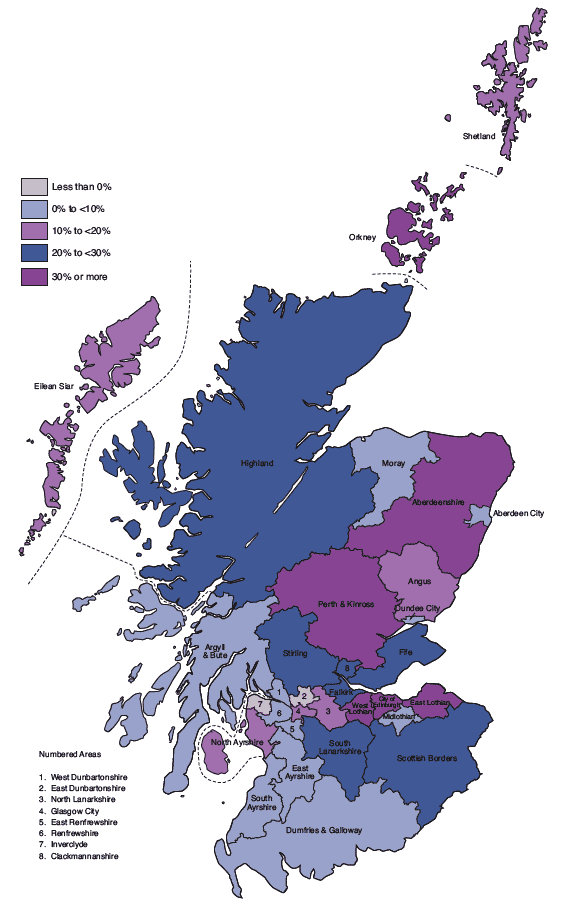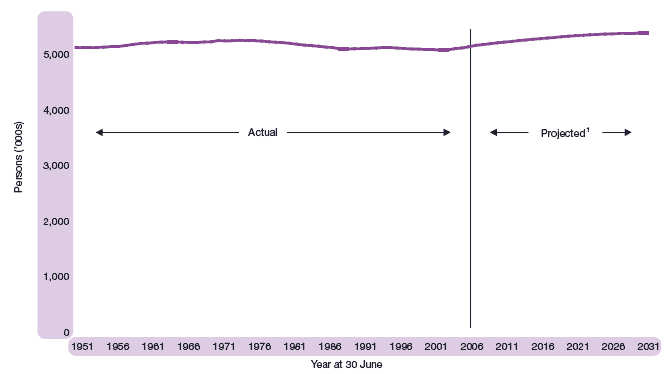
The latest estimate of Scotland’s population (on 30 June 2007) is 5,144,200 – the highest since 1983. The increase of 27,300 people on the previous year was the biggest single year increase since 1946-47. There are almost 90,000 more people in Scotland than in 2002, when the population hit its lowest level since just after the Second World War.
The recent increase in Scotland’s population has been driven mostly by net in-migration although, during 2006-07, there were also more births than deaths. In the twelve months to 30 June 2007, in-migration exceeded out-migration by 26,800. This included a net gain of around 8,800 from the rest of the UK and a net gain of around 16,800 from overseas (including asylum seekers). Movements to and from the armed forces showed a net gain of around 1,200. In the same period, there were around 1,100 more births than deaths (56,730 births and 55,650 deaths), the number of births having risen by almost 1,800 and the number of deaths having risen by almost 400 compared to the year to end June 2006.
The rise in Scotland’s population in the last five years should be seen in the context of the relative stability of the population over the last 50 years, as shown in Figure 1.1. The population reached a peak of 5.24 million in 1974 before falling to 5.05 million in 2002 and then rising again in the last five years.
Figure 1.1 Estimated population of Scotland, actual and projected, 1951-2031

1 2006-based projections.
Figure 1.2 shows the trends in natural change (births minus deaths) and migration. Between 1966 and 1974, both natural change and net out-migration fell dramatically, although the natural increase generally remained greater than net out-migration. This resulted in a growth in population up to 1974. From that point on, through the late 1970s and the 1980s, net out-migration was higher than the natural increase, causing the population to decline. In recent years the gap between births and deaths has closed, and indeed reversed, and Scotland has experienced record levels of net in-migration. So the population has increased, although the increases in the last five years are still relatively small, averaging less than 0.5 per cent per year.
Figure 1.2 Natural change and net migration, 1951-2007
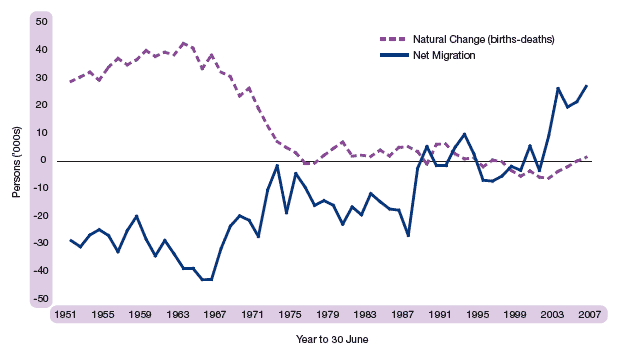
Age Structure
The age/sex composition is one of the most important aspects of the population, as changes in different age groups will have different social and economic impacts. For example, increases in the elderly population are likely to place a greater demand on health and social services.
Figure 1.3 shows the age structure of the population in 2007. Eighteen per cent of the population was aged under 16 while 19 per cent was of pensionable age (60 and over for women and 65 and over for men) and the remaining 63 per cent of working age (16-59 for women, 16-64 for men). Amongst older people, particularly those aged over 75, the higher number of females reflects the longer expectation of life for women, partly as a result of male mortality rates during the Second World War. The sharp peak at age 60, and the bigger bulge between the ages of 35 and 45, are the result of the two baby booms of 1947 and the 1960s.
Figure 1.3 Estimated population by age and sex, 30 June 2007
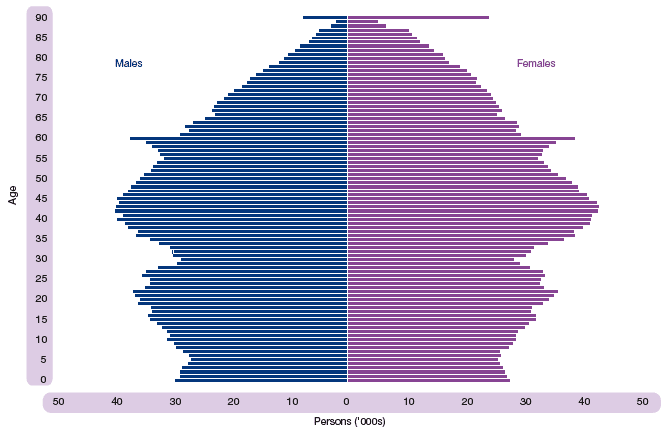
The changing structure of Scotland’s population since 1997 is illustrated in Figure 1.4. During this period the population has increased by around 60,900 (1.2 per cent), from 5.08 million to 5.14 million. Of particular note is the decrease of 9 per cent in the number of children under 16 and the increase of 13 per cent in the number of people aged 75 and over. The ageing of the population is also evident in the rise of 14 per cent in the 45-59 age group, and of 8 per cent in the 60-74 age group.
Figure 1.4 The changing age structure of Scotland’s population, 1997-2007
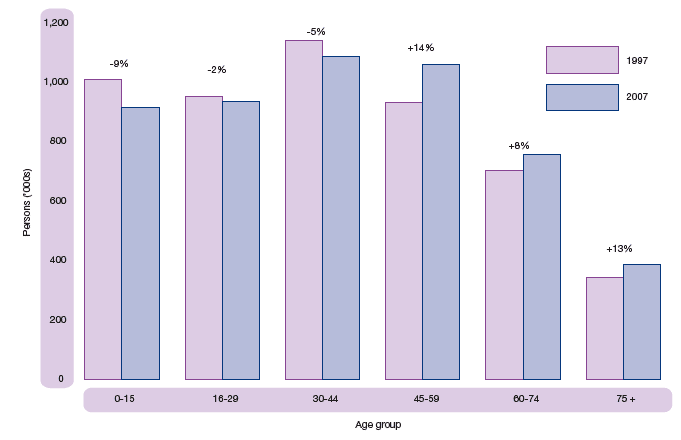
Changes within Scotland
The map at Figure 1.5 shows the percentage change in population between 1997 and 2007 for each Council area.
Figure 1.5 Percentage population change by Council area, 1997-2007
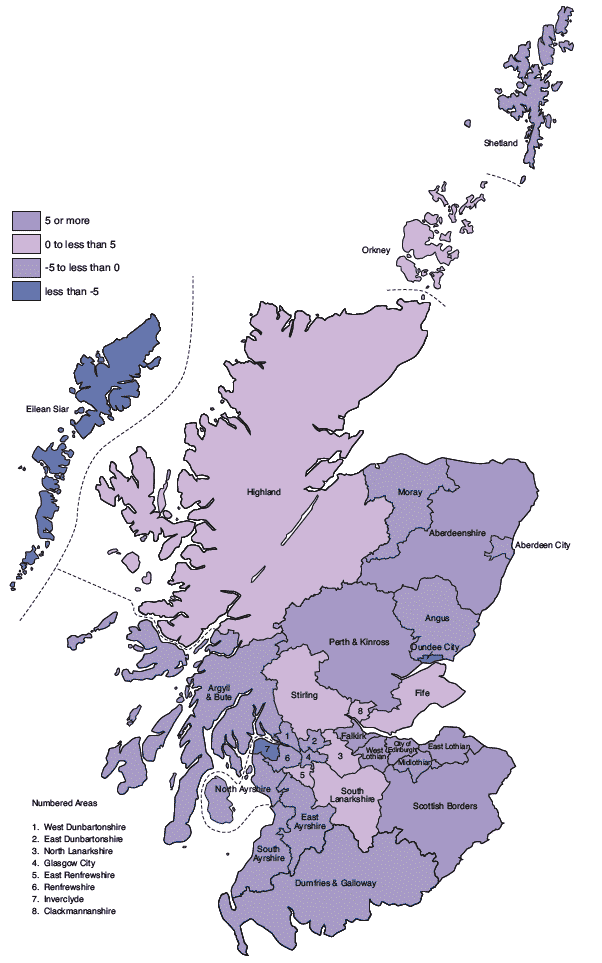
The Council areas in which the population fall was greatest were Inverclyde (-6.2 per cent), Dundee City (-6.1 per cent) and Eilean Siar (-5.8 per cent). The largest absolute reduction in numbers was in Dundee City (-9,200). West Lothian (+10.5 per cent), East Lothian (+7.6 per cent) and Perth & Kinross (+6.1 per cent) saw the greatest percentage increases, with the largest increase in absolute numbers in Edinburgh (+22,350).
The relative importance of migration and natural change differs between areas. In some areas of population increase, such as West Lothian, Aberdeenshire and East Renfrewshire, the gain is attributable both to migration and to natural increase. In other areas, the population increase is due to in-migration, despite fewer births than deaths. These included Perth & Kinross, Scottish Borders, Highland and Fife. Other areas with a population increase but with a near-zero natural change were Falkirk, City of Edinburgh and Clackmannanshire.
Similarly, some areas of population decline, such as Inverclyde, Dundee City, Eilean Siar, West Dunbartonshire and Renfrewshire have experienced decreases both from migration and natural change. In contrast, the main factor in the population decline of the Shetland Islands, East Dunbartonshire and Aberdeen City is net out-migration. In other areas such as South Ayrshire, Argyll & Bute and Dumfries & Galloway the population decline was mainly attributable to more deaths than births. This analysis is shown in Table 1.1, which compares the rates of natural change and migration per 1,000 population across the local authority areas.
Table 1.1 Components of population change for Council areas: 1997-2007
|
Natural |
Net civilian migration |
Percentage |
|---|---|---|---|
SCOTLAND |
-0.6 |
1.8 |
1.2 |
Council areas |
|||
Inverclyde |
-2.7 |
-3.5 |
-6.2 |
Dundee City |
-1.8 |
-4.3 |
-6.1 |
Eilean Siar |
-4.9 |
-0.9 |
-5.8 |
West Dunbartonshire |
-1.4 |
-2.9 |
-4.3 |
East Dunbartonshire |
-0.1 |
-4.0 |
-4.1 |
Shetland Islands |
1.7 |
-5.5 |
-3.9 |
Aberdeen City |
-0.1 |
-3.6 |
-3.7 |
Renfrewshire |
-0.8 |
-2.8 |
-3.5 |
South Ayrshire |
-3.6 |
1.9 |
-1.7 |
East Ayrshire |
-1.6 |
0.1 |
-1.5 |
Glasgow City |
-1.5 |
0.0 |
-1.5 |
North Ayrshire |
-1.4 |
0.0 |
-1.4 |
Argyll & Bute |
-4.0 |
3.6 |
-0.4 |
Moray |
-0.4 |
0.0 |
-0.3 |
Dumfries & Galloway |
-2.9 |
2.7 |
-0.1 |
Angus |
-2.1 |
2.0 |
-0.1 |
Midlothian |
0.8 |
-0.9 |
-0.1 |
Orkney Islands |
-1.9 |
2.3 |
0.5 |
North Lanarkshire |
1.2 |
-0.5 |
0.7 |
East Renfrewshire |
0.9 |
0.7 |
1.6 |
South Lanarkshire |
-0.3 |
1.9 |
1.7 |
Clackmannanshire |
0.1 |
2.7 |
2.8 |
Fife |
-0.5 |
4.5 |
4.0 |
Highland |
-0.9 |
5.2 |
4.3 |
Stirling |
-0.2 |
5.1 |
4.9 |
Edinburgh, City of |
0.2 |
4.8 |
5.0 |
Falkirk |
0.1 |
5.1 |
5.1 |
Scottish Borders |
-2.5 |
7.6 |
5.2 |
Aberdeenshire |
1.5 |
4.3 |
5.8 |
Perth & Kinross |
-2.1 |
8.2 |
6.1 |
East Lothian |
-0.5 |
8.1 |
7.6 |
West Lothian |
3.8 |
6.7 |
10.5 |
1 Per year per 1,000 population at 1997.
2 The underlying data used to produce these figures can be found in Table 7 of the ‘Mid-2007 Population Estimates Scotland’ publication.
3 Ordered by population change.
Projected population
The latest population projections are based on the estimate of Scotland’s population at 30 June 2006. These projections, based on existing trends and making no allowance for the impact of government policies and other factors, show the total population of Scotland rising from 5.12 million in 2006 to 5.37 million in 2031 (Figure 1.1). Longer term projections show the population peaking in 2031 and then slowly declining.
Up until around 2021 natural change and migration both act to increase the size of the population as the number of births exceeds the number of deaths and there is net in-migration. After this point the number of deaths exceeds the number of births whilst the net migration into Scotland continues. By 2031, the natural decrease more than cancels out the net in-migration and so Scotland’s population begins to fall. Figure 1.6 shows the number of births exceeding the number of deaths until 2021 and then the number of deaths rising beyond the number of births and continuing to rise while the number of births falls.
Figure 1.6 Births and deaths, actual and projected, Scotland, 1951-2031
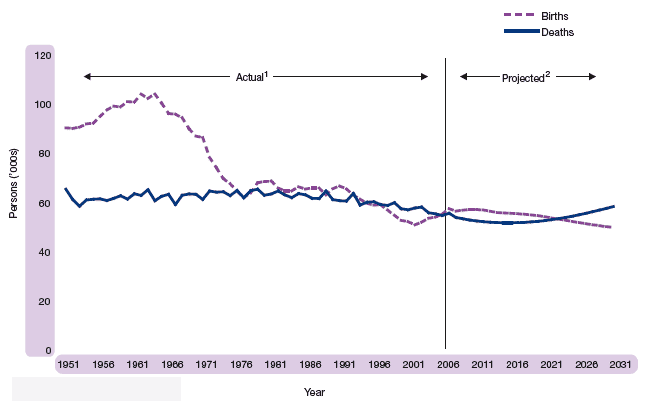
1 Calendar year.
2 2006-based mid-year projections.
Between 2006 and 2031, Scotland’s population is projected to age markedly. As shown in Figure 1.7, the number of children aged under 16 is projected to decrease by 7 per cent, from 0.92 million to 0.86 million. The number of people aged 60 and over is projected to rise by 54 per cent from 1.12 million to 1.72 million.
Figure 1.7 The projected percentage change in age structure of Scotland’s population, 2006-20311
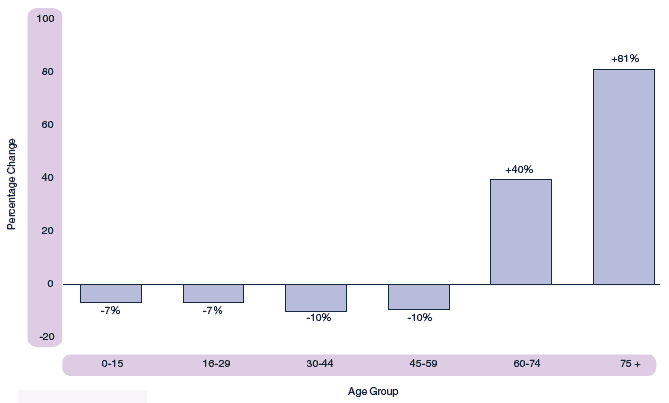
1 2006-based projections
‘Dependency ratios’ are the number of dependants – children aged under 16 and people of pensionable age – per 1,000 working age population. Figure 1.8 shows little overall change in these ratios over the next 15 years, but a relatively rapid increase in the pension age population relative to the working age population in subsequent years. Figure 1.8 also takes account of the increase in the pensionable age for both men and women.1
Figure 1.8 Dependency Ratios1 (per thousand working population), 2006-2031
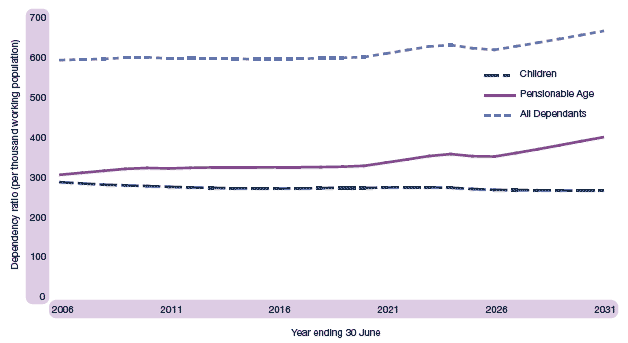
1 2006-based projections
As demographic behaviour is uncertain, a number of variant population projections have been calculated, based on alternative assumptions of future fertility, mortality and migration in addition to the ‘principal projection’ on which the previous paragraphs are based. The variant projections give users an indication of this uncertainty. They illustrate plausible alternative scenarios, rather than representing upper or lower limits of future demographic behaviour. These variant projections, and the assumptions used, can be found on the Government Actuary’s Department (GAD) website (www.gad.gov.uk).
Scotland’s position within Europe
The population of most of the countries in Europe is projected to increase over the next few years. Whilst Scotland’s population is projected to rise by 5.0 per cent between 2006 and 2031, countries such as Ireland and Spain, as well as the rest of the UK, are all projected to have much bigger increases. The population of Europe (EU-27) is projected to increase by 5.5 per cent and the EU-15 by 9.1 per cent during this period. However Germany, and a number of Eastern European countries, have a projected population decline as Figure 1.9 shows.
Figure 1.9 Projected percentage population change in selected European countries 2006-2031
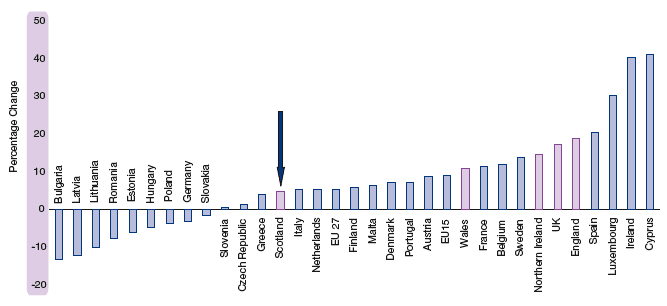
Source: ONS (UK and constituent countries) and Eurostat. Eurostat projections are 2008 based so the 2006 population estimates have been compared to the projected population for 2031. See "Appendix 2 – Notes and Definitions" for definition of EU15 and EU27.
Scotland is not alone in having an ageing population. The pattern of change over the last twenty years and the projected change in the age distribution is similar to that of other countries in the UK and Europe, although the rate of change varies.
Numbers
The number of births registered in Scotland in 2007 was 57,781. This was 2,091 (3.8 per cent) more than in 2006 and 6,511 (12.7 per cent) more than 2002’s total – which was the lowest since civil registration began in 1855, with only half the number of births recorded during the ‘baby boom’ of the early 1960s. Increases have been recorded in each year since 2002. The number of births and deaths registered in Scotland since 1951 is shown in Figure 1.10.
Figure 1.10 Births and deaths, Scotland, 1951-2007
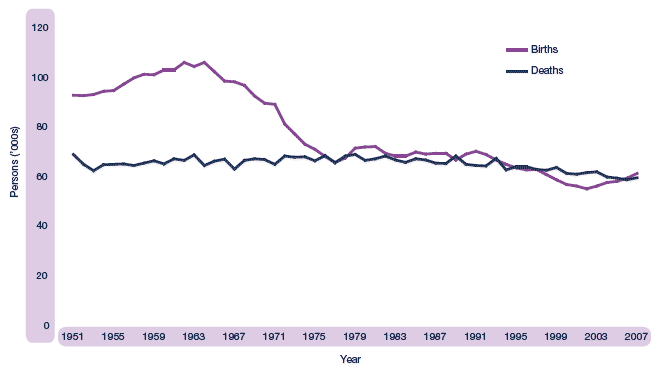
The proportion of births to unmarried parents (including births registered solely in the mother’s name) has continued to rise, reaching 49.1 per cent in 2007 compared to 37.7 per cent ten years earlier and 22.8 per cent in 1987. However, the proportion of births registered solely in the mother’s name has remained relatively constant over the past twenty years at around 7 per cent, falling to around 6 per cent in each of the last five years, suggesting that the increase in births to unmarried parents has been in babies born to unmarried partners who are in a stable relationship.
Fertility Rates
The simplest fertility rate is the crude birth rate which is defined as the number of live births per 1,000 total population. Appendix 1 Table 1 shows that in 2007 the crude birth rate for Scotland stood at 11.2 compared with around 20 forty years ago. Because it takes no account of the age/gender structure of the population, the crude birth rate has only limited value (e.g. for giving rough comparisons between areas with broadly similar age/gender structures). Appendix 1 Tables 2 and 3 present crude birth rates for administrative areas in Scotland and selected European countries. Appendix 1 Table 2 also gives standardised birth rates for the administrative areas of Scotland: these adjusted birth rates take account of the population structures in the different areas.
A better approach is to consider the general fertility rate (GFR) which is based on the numbers of women of childbearing age. Figure 1.11 shows the general fertility rate (births per 1,000 females aged 15-44), along with the number of women aged 15-44. During the ‘baby boom’ of the 1960s, the GFR reached 99.5 (in 1962). It then fell sharply to around 60 during the late 1970s and 1980s before declining more slowly during the 1990s, eventually dipping below 50 at the start of the 21st century. It has risen slightly over the last few years to its 2007 value of 54.8. Interestingly, the figure shows that the female population aged 15-44 was relatively low during the baby boom of the 1960s. Moreover, the levelling off in the annual numbers of births during the 1980s was in part associated with the increasing numbers of women born in the 1950s and 1960s, passing through their childbearing years.
Figure 1.11 Estimated female population aged 15-44 and general fertility rate (GFR), Scotland, 1951-2007
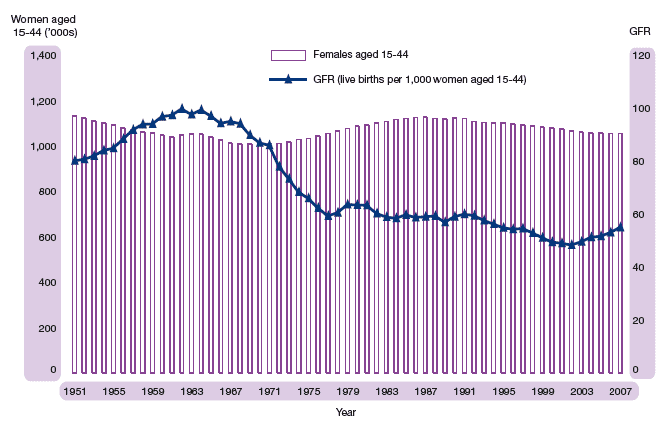
A more detailed picture is given by the age specific fertility rates (ASFRs) by mother’s age in five-year age groups in Figure 1.12. This shows many significant age-related features of the pattern of childbearing over the last fifty years. The key point is that, as well as choosing to have fewer babies, women are also choosing to have them later in life. Other points of interest are:
Figure 1.12 Live births per 1,000 women, by age of mother, Scotland, 1951-2007
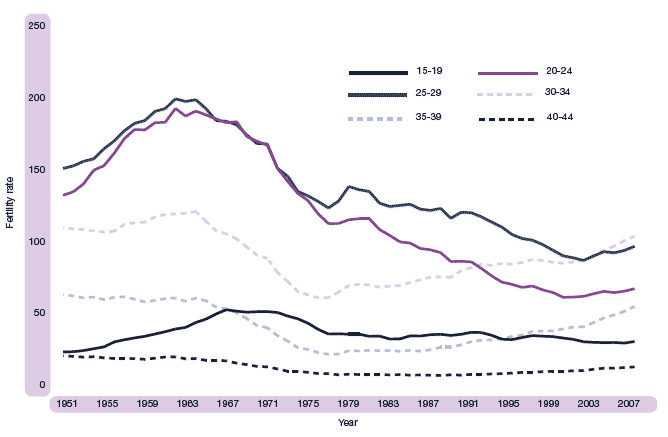
Figure 1.13 further illustrates the ageing pattern of fertility by showing detailed ASFRs for selected years: 1951, 1964, 1977, 1991 and 2007. Though the levels differed considerably, the age patterns of fertility for 1951, 1964 and 1977 were roughly the same. However, the age distribution for 1991 shows a distinctly older peak and that for 2007 reveals the large reduction in fertility of women in their twenties.
The trend towards later childbearing is underlined by changes in the average age of mothers for all births. This was 29.4 in 2007, compared with 27.4 in 1991, 26.1 in 1977, and 27.4 in 1964.
Figure 1.13 Live births per 1,000 women, by age, selected years
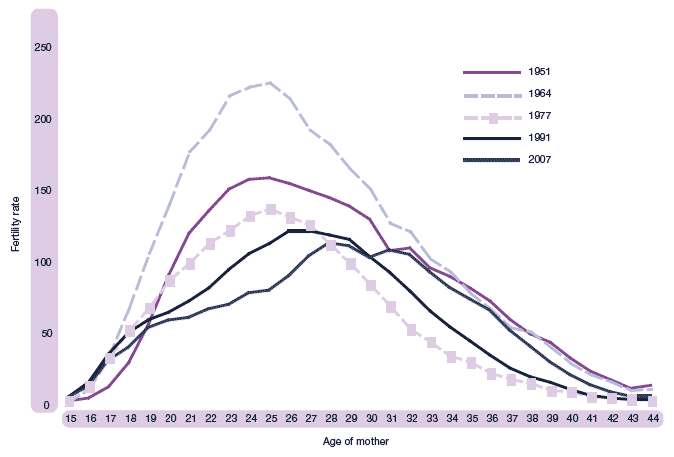
The total fertility rate (TFR) is a commonly used summary measure of fertility levels calculated by summing the age specific rates for a single year. It gives the average number of children that a group of women would expect to have if they experienced the observed ASFRs in each of their childbearing years. For a population to replace itself, the TFR needs to be around 2.1.
The TFR for Scotland since 1951 is plotted in Figure 1.14. Not surprisingly, it follows the same general pattern as the GFR described above. It rose to 3.09 in 1964 before dropping sharply to 1.70 in 1977. Since then, with a few minor fluctuations, it fell more slowly to the 2002 rate of 1.48 before increasing to 1.60 in 2004 and 1.73 in 2007.
Figure 1.14 Total fertility rate, Scotland, 1951-2007
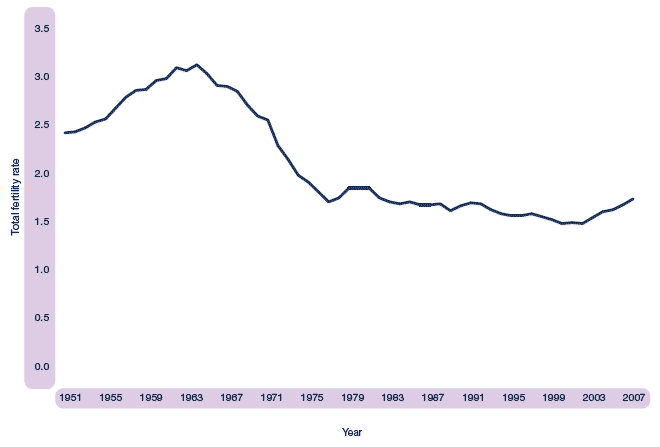
Though widely used, in part because it is relatively easy to calculate, the TFR has serious deficiencies as it is based on only one year’s observations. For example, when women are delaying childbearing, as they have been in Scotland, the TFR is likely to underestimate the number of children women will eventually have.
A more satisfactory measure is average completed family size. Figure 1.15 shows the completed family size (or cumulative cohort fertility) by age for women born in selected years. Those born in 1951 had attained an average completed family size of 2.03 by the time they reached 45, whereas for those born in 1956 the figure was 1.93. The figure also permits the comparison of family size at selected ages for the various cohorts as they pass through the childbearing ages. For example, by age 30 the cumulative childbearing of the 1971 cohort is about 0.6 lower than that of the 1951 cohort. Of crucial importance is the extent to which the later cohorts are falling behind in family building. Whilst the increasing fertility rates of those aged over 30 may lead to some catching-up, it is highly unlikely that this will increase the average completed family size to the levels attained as recently as the 1960s.
Figure 1.15 Cumulative cohort fertility rate for selected birth cohorts, Scotland
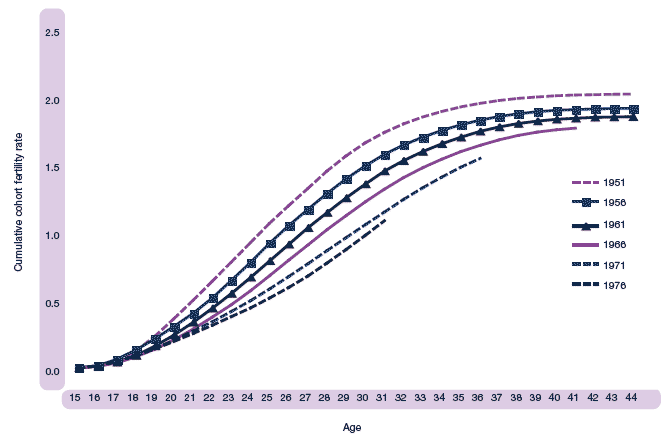
Since the early 1980s Scotland’s fertility has been lower than fertility in other parts of the United Kingdom. Figure 1.16 compares the TFRs for England, Wales, and Northern Ireland since 1971 with those for Scotland. Until the late 1970s, Scotland’s TFR was slightly higher than that for England and Wales. However, since the early 1980s, Scotland’s TFR has dropped steadily below the levels for England and Wales. In 1971 the TFR for Northern Ireland was markedly higher than for the other three countries. However, since then the differential has been significantly reduced. It is interesting to note that the recent slight rise in fertility levels in Scotland has been paralleled elsewhere in the UK and Scotland’s TFR is now at its highest level for 25 years.
Figure 1.16 Total fertility rates, UK countries, 1971-2007
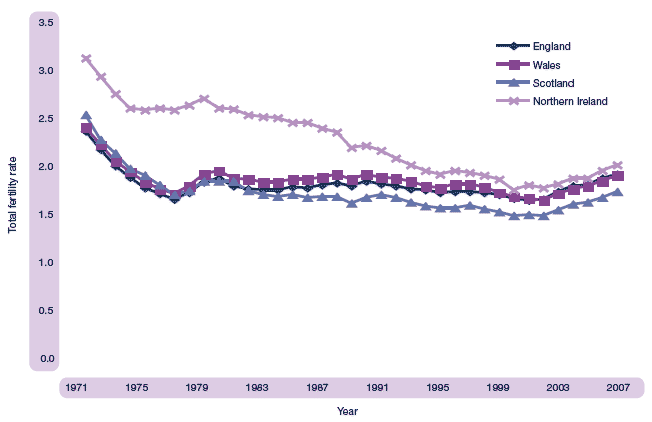
More information on births and fertility is given in Chapters 2 and 3 of this report.
Numbers
At 55,986, the number of deaths registered in Scotland in 2007 was 893 (1.6 per cent) more than in 2006.
Figure 1.10 shows that from 1951 up to the early 1990s the annual number of deaths remained relatively stable at about 60-65,000 a year. The total then declined slowly to just under 55,100 in 2006, which was the lowest annual total recorded since the introduction of civil registration in 1855.
Stillbirths, perinatal deaths and infant deaths
As can be seen in Figure 1.17, there have been significant improvements in the rates for stillbirths, perinatal deaths and infant deaths in the period since 1971. The stillbirth rate has reduced from 13.1 per 1,000 total births (live and still) in 1971 to 5.5 in 2007, despite a change in the definition of stillbirths in 1992 which reduced the minimum period of gestation from 28 weeks to 24 weeks (thus increasing the numbers classified as stillbirths). The rate of perinatal deaths (stillbirths and deaths in the first week of life) fell from 24.5 per 1,000 total births in 1971 to 8.3 in 2007. The infant death rate (deaths of children aged under 1) fell from 19.9 per 1,000 live births in 1971 to 4.7 in 2007.
Figure 1.17 Stillbirth, perinatal and infant death rates, per 1,000 total births, Scotland 1971-2007
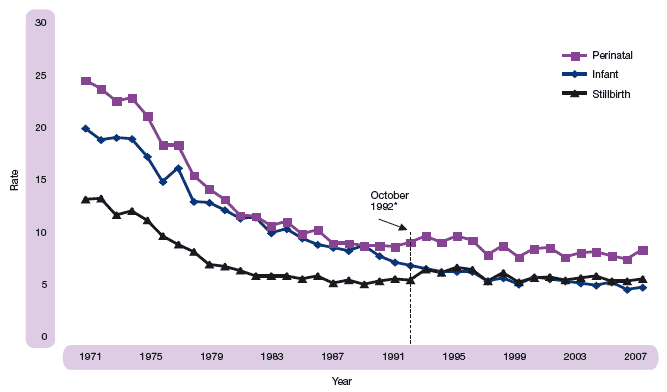
* Change in definition from 28 to 24 weeks gestation.
Whilst the current rates are comparable to those for the UK as a whole, Figures 1.18 and 1.19 show that there are several European countries that have significantly lower rates (see also Appendix 1, Table 3).
Figure 1.18 Stillbirth rate per 1,000 live and still births, selected countries, latest available figures
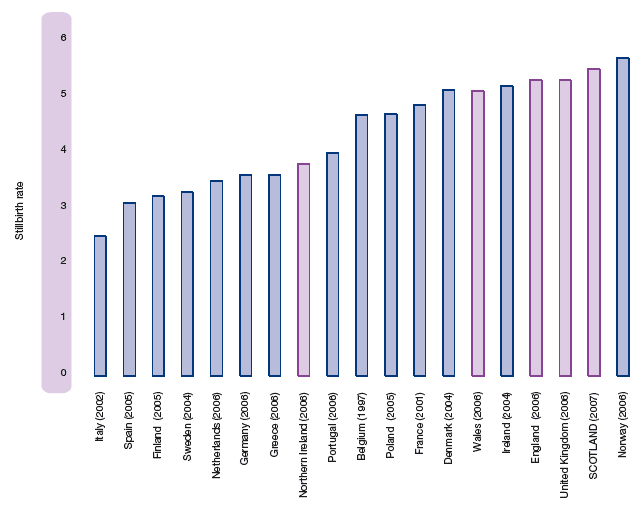
Figure 1.19 Infant death rate per 1,000 live and still births, selected countries, latest available figures
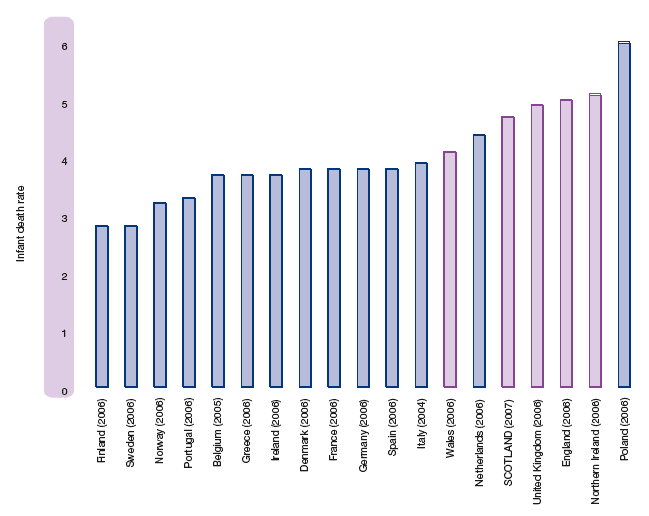
Mortality by age
About 60 per cent of deaths were of people aged 75 and over, and a further 19 per cent were between the ages of 65 and 74.
The relative stability in the total number of deaths over recent years masks significant improvements in age-specific mortality. Figure 1.20 shows, for both men and women, selected age-specific mortality rates over the last quarter of a century relative to the 1981 rates. The three age groups shown (45-64, 65-74 and 75 and over) account for around 95 per cent of all deaths.
At these ages, there have been greater improvements in male than in female mortality. For the 45-64 age group, males and females experienced improvements of 44 per cent and 40 per cent respectively. In the 65-74 age group, males showed an improvement of 45 per cent compared to 37 per cent for females. The greatest differential is in the 75 plus age group, where male mortality has improved by 27 per cent compared to only 14 per cent for females. These changes have narrowed the difference between female and (traditionally higher) male mortality.
Figure 1.20 Age specific mortality rates as a proportion of 1981 rate, 1981-2007
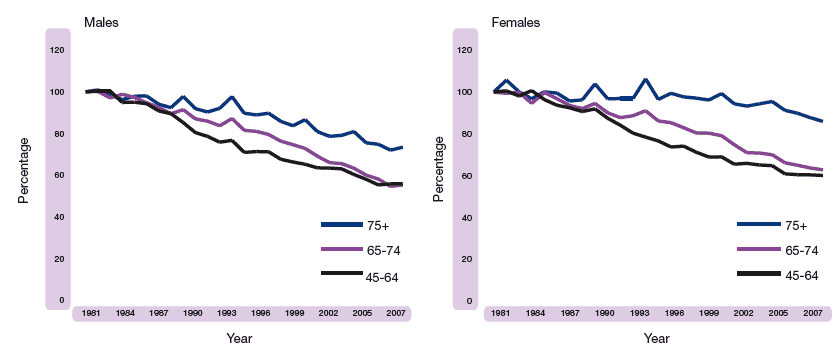
Life Expectancy
Although mortality rates in Scotland have generally fallen more slowly than in the rest of the UK and elsewhere in Europe, the improvements are still considerable and the impact is demonstrated in the steadily rising expectation of life.
The expectation of life at birth is a commonly used measure of mortality which is particularly helpful in comparing the ‘health’ of a nation through time and for making comparisons with other countries. Figure 1.21 shows that the expectation of life at birth in Scotland has improved greatly over the last 25 years or so, increasing from 69.1 years for men and 75.4 years for women born around 1981 to 74.8 years and 79.7 years respectively for those born around 2006. Figure 1.21 also illustrates that improvements in life expectancy at birth are projected to continue, rising to 80.4 years for men and 84.8 years for women by 2031.
Figure 1.21 Expectation of life at birth1, Scotland, 1981-2031
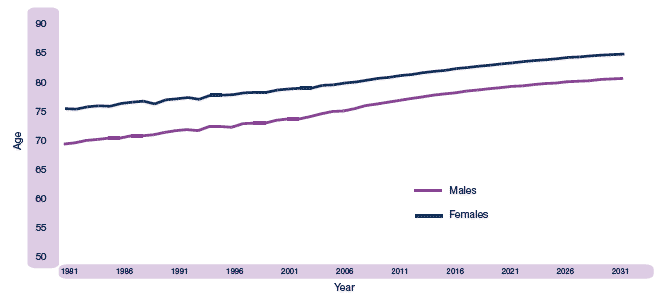
1 Source: Figures to 2006 from Interim Life Tables, ONS.
These are based on 3 years of data. E.g. 2006 figure uses data for 2005-2007.
Figures after 2006 are projected single year life expectancies, ONS.
However, Figures 1.22a and 1.22b show that Scottish men and women have among the lowest expectation of life at birth in the European Union. The countries with lower life expectancy than Scotland were most of the Eastern European states which joined the EU on 1 May 2004. For both sexes the expectation of life is about 4 years lower than the countries with the highest expectation of life.
Figure 1.22a Life expectancy at birth, 2005, selected countries, Males
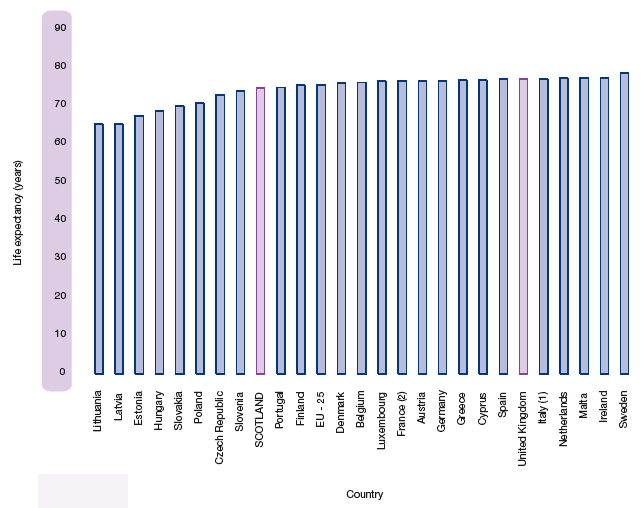
(1) 2003
(2) 2004
Source: EUROSTAT and GROS
Figure 1.22b Life expectancy at birth, 2005, selected countries, Females
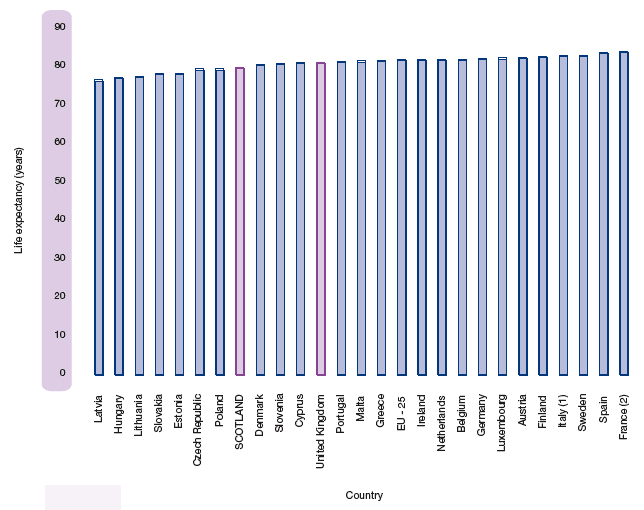
(1) 2003
(2) 2004
Source: EUROSTAT and GROS
Variations in mortality levels within Scotland
Standardised mortality ratios (SMRs), which compare local death rates with death rates in Scotland as a whole, taking account of the different population structure of each area, are presented in Figure 1.23. Four of the 32 Scottish Council areas have a standardised mortality ratio that is more than 10 per cent higher than the Scottish average of 100. These are all in West Central Scotland. The worst, Glasgow City, is 26 per cent higher than the Scottish average which itself is about one-sixth higher than the UK average.
At the other end of the scale, 6 of the 32 Council areas have a standardised mortality ratio that is more than 10 per cent lower than the Scottish average. The lowest were East Dunbartonshire and East Renfrewshire which were both 16 per cent below (or better than) the Scottish average.
Figure 1.23 Standardised mortality ratios, by Council area, 2007
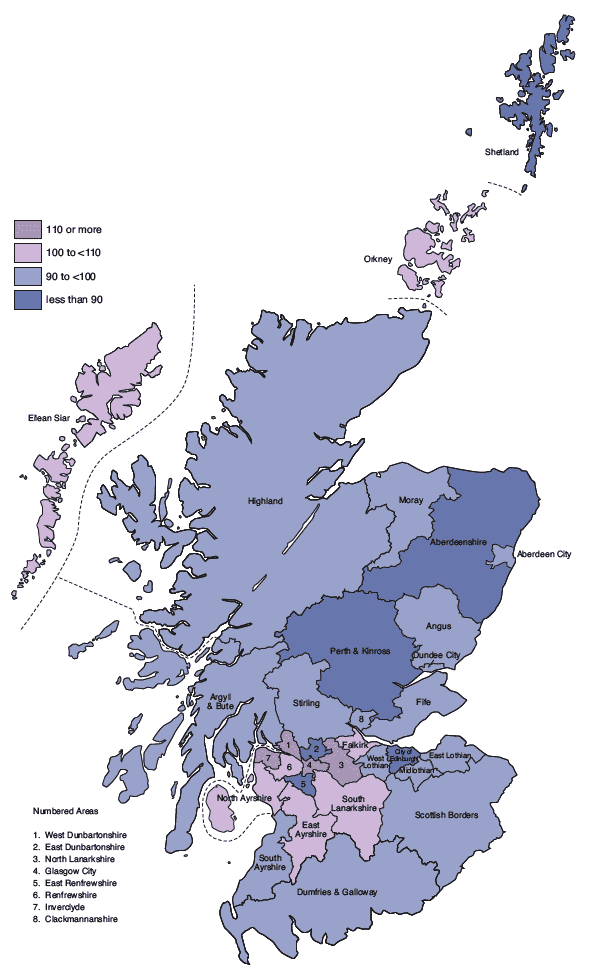
Causes of death
In 2007, the two most common causes of death in Scotland were cancer (15,274 deaths, 27 per cent of all deaths) and ischaemic (coronary) heart disease (9,343 deaths, 17 per cent). However, since 1981 the proportion of deaths caused by ischaemic heart disease has fallen from 29 to 17 per cent, whereas the proportion caused by cancer has risen from 22 to 27 per cent. Since 1995 there have been more deaths from cancer than ischaemic heart disease.
Cancer
Death rates, by sex, for the most common causes of death are shown in Table 1.2. Over the last 25 years or so, male death rates from lung cancer have fallen by almost a quarter (from 119 per 100,000 population in 1980-82 to 90 in 2007). By contrast, the rates for women, though still considerably lower than those for men, have increased by 73 per cent (from 41 per 100,000 population in 1980-82 to 71 in 2007).
Heart disease and stroke
Table 1.3 shows the number of deaths for males and females for the most common causes of death. In contrast to the rises for cancer, death rates for ischaemic heart disease (coronary heart disease) and cerebrovascular disease (stroke) have shown significant declines. Between 1981 and 2007, rates for males had improved by 48 per cent for ischaemic heart disease and 41 per cent for stroke compared with improvements of 50 and 42 per cent respectively for females.
Table 1.2 Death rates from selected causes, by sex, Scotland, 1980-2007
Males – rates per 100,000 population |
|||||
|---|---|---|---|---|---|
Year |
All types |
Cancer |
Ischaemic heart |
Cerebrovascular |
|
Trachea, bronchus |
Prostate |
||||
1980-82 |
291 |
119 |
19 |
408 |
139 |
1990-92 |
314 |
111 |
27 |
367 |
119 |
2000-02 |
321 |
93 |
32 |
261 |
101 |
2007 |
313 |
90 |
32 |
212 |
82 |
Females – rates per 100,000 population |
|||||
Year |
All types |
Cancer |
Ischaemic heart |
Cerebrovascular |
|
Trachea, bronchus |
Breast |
||||
1980-82 |
247 |
41 |
45 |
304 |
210 |
1990-92 |
278 |
57 |
48 |
297 |
191 |
2000-02 |
288 |
64 |
43 |
216 |
162 |
2007 |
281 |
71 |
40 |
154 |
124 |
Table 1.3 Number of deaths from selected causes, by sex, 1980-2007
Year |
Cancer |
Ischaemic heart disease |
Cerebrovascular disease |
|||
|---|---|---|---|---|---|---|
Males |
Females |
Males |
Females |
Males |
Females |
|
1980-821 |
7,269 |
6,634 |
10,173 |
8,150 |
3,470 |
5,638 |
1990-921 |
7,664 |
7,324 |
8,964 |
7,846 |
2,913 |
5,029 |
2000-021 |
7,674 |
7,394 |
6,342 |
5,664 |
2,465 |
4,250 |
2007 |
7,783 |
7,491 |
5,260 |
4,083 |
2,039 |
3,294 |
1 Average over 3 year period.
Table 1.4 shows the number of deaths in 2007 from cancer, by type, along with heart disease and stroke.
Of the 15,274 deaths from cancers in 2007, trachea, bronchus and lung was the most common type, accounting for over a quarter (27 per cent) of all cancer deaths.
The next most frequent type of cancer death was bowel for men (812 deaths, of which 47 per cent were aged 75 and over) and breast for women (1,062 deaths, of which 42 per cent were aged 75 and over). Death rates for these two causes have been relatively stable in recent years.
Table 1.4 Deaths from cancer, heart disease and stroke, Scotland, 2007
|
Persons |
Males |
Females |
|---|---|---|---|
| All cancers | 15,274 |
7,783 |
7,491 |
Type of cancer |
|||
Trachea, bronchus and lung |
4,115 |
2,239 |
1,876 |
Bowel |
1,539 |
812 |
727 |
Breast |
1,067 |
5 |
1,062 |
Lymphoid, haematopoietic etc |
1,044 |
554 |
490 |
Urinary tract |
876 |
541 |
335 |
Prostate |
793 |
793 |
– |
Oesophagus |
786 |
485 |
301 |
Pancreas |
713 |
338 |
375 |
Stomach |
506 |
304 |
202 |
Ovary |
381 |
– |
381 |
Liver |
378 |
256 |
122 |
Other |
3,076 |
1,456 |
1,620 |
Ischaemic heart disease |
9,343 |
5,260 |
4,083 |
Cerebrovascular disease |
5,333 |
2,039 |
3,294 |
Average age at death
The average age at death has increased steadily over the past thirty years. Figure 1.24 shows that the average ages at death for cancer, heart disease and stroke have generally increased in line with the average for all deaths.
Figure 1.24 Average age at death, selected causes, Scotland, 1977-2007
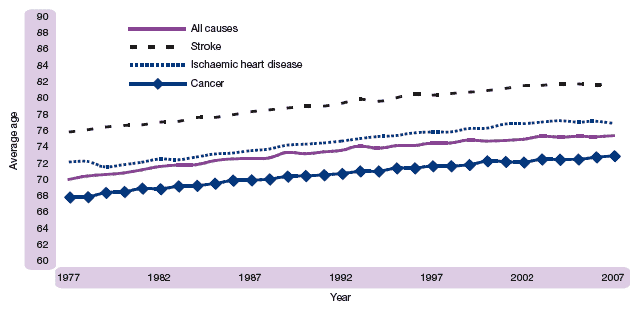
Using 2006 data, the latest available, Figure 1.25 compares the death rates for the constituent countries of the UK for selected causes after adjusting for differences in age structure. The Scottish rates for cancer, ischaemic heart disease, and cerebrovascular disease (stroke) are well above the rates for the other countries of the United Kingdom for both men and women.
Figure 1.25 Age-adjusted mortality rates, by selected cause and sex, 2006
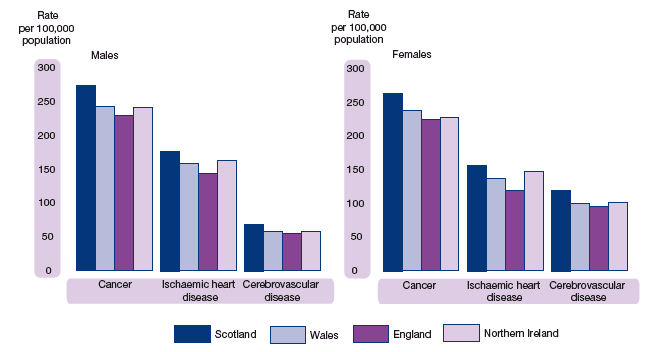
Suicides
In 2007, deaths from intentional self-harm numbered 517 (386 males and 131 females), 25 fewer than in 2006. To allow for any under-recording of suicides, it is conventional to combine deaths classified as ‘events of undetermined intent’ with those for ‘intentional self-harm’, as most of the former are believed to be suicides. The total number of deaths classified to these two groups in 2007 was 838 compared with 765 in 2006 and 763 in 2005.
Suicide is the most common cause of death for men aged 15-44. For men the most frequent cause of these deaths was hanging, strangulation and suffocation, whereas for women it was poisoning.
Main causes of death by age and sex
The main causes of death vary in frequency by age and sex (Figure 1.26). Cancer was the largest single cause amongst boys aged 1-14, followed by respiratory diseases and accidents. For girls aged 1-14, cancer was the most common cause.
For males aged 15-34, the largest cause was suicide (intentional self-harm plus events of undetermined intent) followed by mental disorders (almost entirely associated with drug and alcohol abuse) and accidents. For females in this age group, cancer was the largest category. Suicides and mental disorders were the next most common causes.
Suicide was also the most frequent cause of deaths for males aged 35-44, mental disorders were second followed by ischaemic heart disease. For women aged 35-44, cancer was the main cause.
For both sexes and all age groups between 45 and 74, cancer was the main cause of death followed by ischaemic heart disease. Cancer was responsible for a higher proportion of deaths in these age groups for men than for women.
Figure 1.26 Deaths, by cause and age group, Scotland, 2007
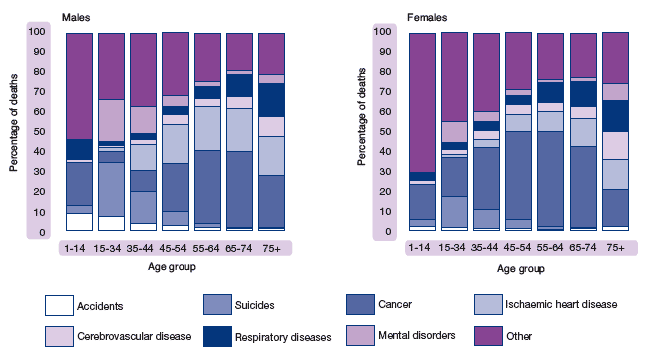
Unlike some countries, the UK does not have a comprehensive system of recording migrants, particularly those leaving the country, nor any legal requirement to notify change of address. So migration is the most difficult component of population change to measure and predict. Migration and the reasons for migrating are also much more susceptible to short-term changes in social and economic circumstances than births and deaths. The Registrar General’s Annual Report for 2003 includes a full analysis of migration data for Scotland. This included analysis of Census 2001 information and gave an overview of data used in the population estimates for Scotland. More detailed information on migration methodology is available on our website.
http://www.nrscotland.gov.uk/statistics-and-data/statistics/statistics-by-theme/migration.
Trends in migration since 1951
Historically, Scotland has been a country of net out-migration, with more people leaving Scotland to live elsewhere than moving to live in Scotland. However, since the 1960s, net out-migration has greatly reduced and in some years during the late 1980s and early 1990s Scotland experienced net migration gains. This has also been the case in the last five years, with net gains of around 9,000 in the year to mid-2003, 26,000 to mid-2004, 19,000 to mid-2005, 21,000 to mid-2006 and 27,000 to mid-2007. This most recent net migration gain is the highest level recorded since current records started in 1952. This can be seen in Figure 1.27.
Figure 1.27 Estimated net migration, Scotland, 1951-2007
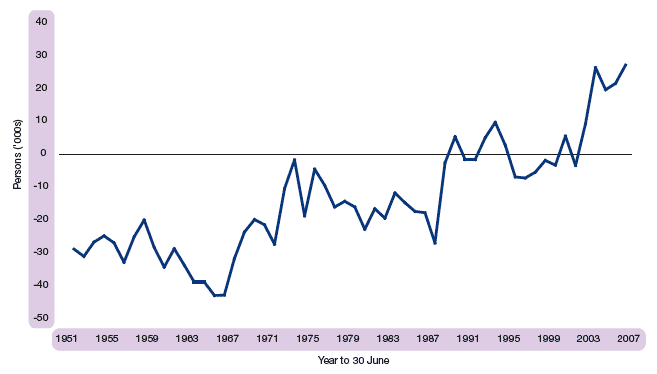
Source: National Health Service Central Register (NHSCR) patient movements.
Net migration is the difference between much larger flows of migrants into and out of Scotland. The level of net migration can be significantly affected by relatively small changes in these gross flows from year to year, particularly if one flow rises while the other falls. In the last five years, migration into Scotland has typically been about 70,000 to 100,000 whilst migration from Scotland has ranged from around 65,000 to around 75,000.
In the year to 30 June 2007, around 51,500 people came to Scotland from England, Wales and Northern Ireland and around 42,700 people left Scotland to go in the opposite direction. The net inflow of around 8,800 is very slightly lower than the previous year’s 8,900 net inflow.
During the same period, about 37,800 people came to Scotland from overseas and around 21,000 left Scotland to go overseas, giving a record net migration gain from overseas of around 16,800. This compares to a net inflow of 12,700 in the previous year which was itself a record. Estimating international migration is particularly difficult as the estimate is based primarily on the International Passenger Survey (IPS). This is a sample survey conducted at main airports and ports across the UK, and the sample size for Scotland is very small (around 180 contacts in 2006-07). Internationally, migrants are defined as people who change their country of usual residence for 12 months or more. So short-term seasonal migrant workers, including many from the Eastern European states which joined the EU in 2004, will not be counted in the migration estimates, and hence will not be included in the mid-year population estimates. The Office for National Statistics (ONS) is currently leading UK-wide work into ways of quantifying short-term migrants.
Origins and destinations of UK migrants
Figure 1.28 illustrates the trend in flows of people to and from the rest of the UK since 1981. In-migration peaked in 2004 and has been falling since, whilst out-migration has been falling since 1999.
Figure 1.28 Movements to/from the rest of the UK, 1981 to 2007
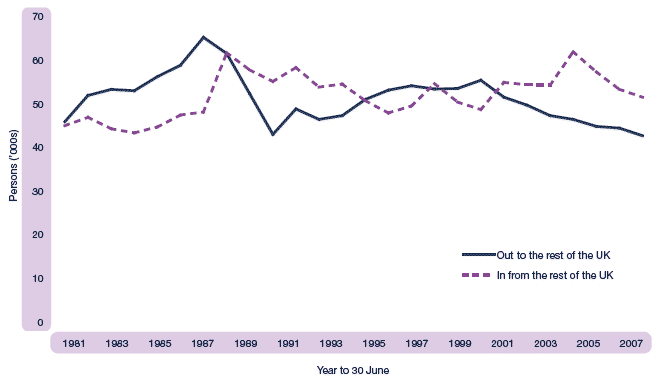
Source: National Health Service Central Register (NHSCR) patient movements.
Table 1.5 shows that 93 per cent of people coming to Scotland from the rest of the UK came from England. Sixteen per cent came from the South East, 15 per cent from the North West, 13 per cent from London, 10 per cent from Yorkshire and the Humber, 9 per cent from the East, 8 per cent from both the North East and South West and 7 per cent from both the East Midlands and the West Midlands. The proportions of people going to the areas of England from Scotland were similar. For example, about 15 per cent went to the North West and another 15 per cent went to London.
Table 1.5 Movements between Scotland and the rest of the UK by Country and Region, mid-2006 to mid-2007
|
Rest of UK |
% of |
Rest of UK |
% of |
Net |
|---|---|---|---|---|---|
England |
47,970 |
93 |
38,467 |
90 |
9,503 |
North East |
4,270 |
8 |
3,497 |
8 |
773 |
North West |
7,808 |
15 |
6,281 |
15 |
1,527 |
Yorkshire and the Humber |
5,405 |
10 |
3,921 |
9 |
1,484 |
East Midlands |
3,529 |
7 |
2,839 |
7 |
690 |
West Midlands |
3,371 |
7 |
2,508 |
6 |
863 |
East |
4,686 |
9 |
3,480 |
8 |
1,206 |
London |
6,866 |
13 |
6,226 |
15 |
640 |
South East |
8,001 |
16 |
6,046 |
14 |
1,955 |
South West |
4,034 |
8 |
3,669 |
9 |
365 |
Wales |
1,772 |
3 |
1,588 |
4 |
184 |
Northern Ireland |
1,804 |
3 |
2,642 |
6 |
-838 |
Total |
51,546 |
100 |
42,697 |
100 |
8,849 |
Age and sex of migrants
Figure 1.29 illustrates the age/sex distribution for men and women moving between Scotland and the rest of the UK between mid-2006 and mid-2007. The peak ages for both males and females migrating into Scotland are 19 and 20. This creates a marked net migration gain at these ages. The peak ages for migrating out of Scotland on the other hand are 23 and 24 and this results in a net migration loss at these ages. These patterns are consistent with an influx of students from outside Scotland starting higher education, followed by a further move after graduation.
Figure 1.29 Movements between Scotland and the rest of the UK, by age, mid-2006 to mid-2007
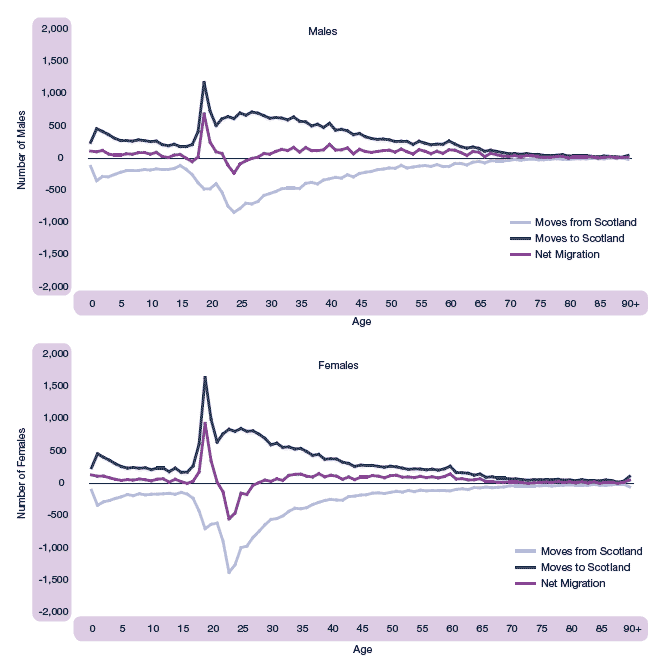
There also tend to be smaller peaks for moves of the very young, under the age of 5, as their parents move home before their children have started school. Later in life, there is no significant "retirement migration" in either direction. The pattern of migration is very similar for men and women, although more women than men appear to migrate in their early 20s. However, this may reflect different patterns of re-registering with an NHS doctor after a move (the main data source for migration estimates) rather than different patterns of migration.
The age and sex of migrants remain relatively constant from year to year. Figure 1.30 shows that, in the year to mid-2007, Scotland gained people of all age groups from the rest of the UK. Movement of all age groups into Scotland has increased since 2001 although fewer people entered, again in all age groups, than in the years to mid-2004 and mid-2005.
Figure 1.30 Net movements between Scotland and the rest of the UK by age group, 2001-2007
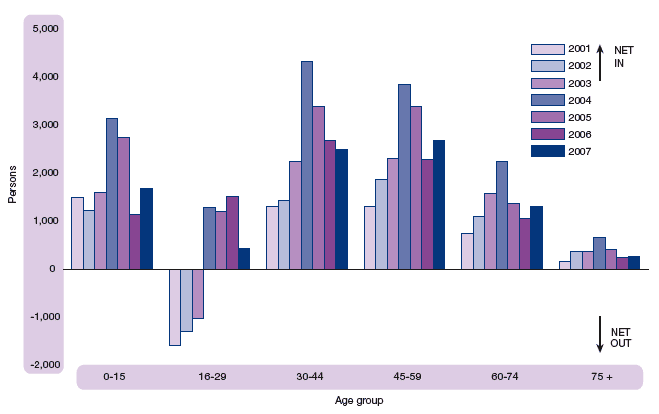
Source: National Health Service Central Register (NHSCR) patient movements.
Table 1.6 shows movements to/from the UK and overseas between mid-2006 and mid-2007 by age group. Migrants tend to be much younger than the general population: 46 per cent of in-migrants from the rest of the UK and 68 per cent of those from overseas are aged 16-34, compared with 24 per cent of the resident population. No significant retirement migration is evident, as only 5 per cent of people coming to Scotland from the rest of the UK were aged 65 and over, as were an estimated 1 per cent of overseas migrants.
Table 1.6 Rest of UK/Overseas moves by age group: 2006-2007
Numbers |
||||||||||
|---|---|---|---|---|---|---|---|---|---|---|
Movements between Scotland and the rest of the UK1 |
||||||||||
|
0-15 |
16-24 |
25-34 |
35-44 |
45-54 |
55-64 |
65-74 |
75-84 |
85+ |
All ages |
IN |
7,962 |
11,230 |
12,597 |
8,042 |
5,115 |
3,885 |
1,556 |
796 |
363 |
51,546 |
OUT |
6,289 |
10,150 |
12,472 |
6,321 |
3,292 |
2,236 |
1,043 |
606 |
288 |
42,697 |
NET |
1,673 |
1,080 |
125 |
1,721 |
1,823 |
1,649 |
513 |
190 |
75 |
8,849 |
Movements between Scotland and Overseas (including asylum seekers, excluding unmeasured migration adjustment)2 |
||||||||||
|
0-15 |
16-24 |
25-34 |
35-44 |
45-54 |
55-64 |
65-74 |
75-84 |
85+ |
All ages |
IN |
5,681 |
12,456 |
13,155 |
3,709 |
1,661 |
721 |
289 |
100 |
28 |
37,800 |
OUT |
3,034 |
4,963 |
6,349 |
3,165 |
1,572 |
1,032 |
483 |
268 |
134 |
21,000 |
NET |
2,647 |
7,493 |
6,806 |
544 |
89 |
-311 |
-194 |
-168 |
-106 |
16,800 |
Total net migration (including asylum seekers, movements to and from the armed forces and rounding adjustments)3 |
||||||||||
|
0-15 |
16-24 |
25-34 |
35-44 |
45-54 |
55-64 |
65-74 |
75-84 |
85+ |
All ages |
NET |
4,541 |
8,444 |
7,310 |
2,763 |
2,046 |
1,389 |
325 |
24 |
-31 |
26,811 |
Percentages |
||||||||||
Movements between Scotland and the rest of the UK1 |
||||||||||
|
0-15 |
16-24 |
25-34 |
35-44 |
45-54 |
55-64 |
65-74 |
75-84 |
85+ |
All ages |
IN |
15 |
22 |
24 |
16 |
10 |
8 |
3 |
2 |
1 |
100 |
OUT |
15 |
24 |
29 |
15 |
8 |
5 |
2 |
1 |
1 |
100 |
Movements between Scotland and Overseas (including asylum seekers and movements to and from armed forces)2 |
||||||||||
|
0-15 |
16-24 |
25-34 |
35-44 |
45-54 |
55-64 |
65-74 |
75-84 |
85+ |
All ages |
IN |
15 |
33 |
35 |
10 |
4 |
2 |
1 |
0 |
0 |
100 |
OUT |
14 |
24 |
30 |
15 |
7 |
5 |
2 |
1 |
1 |
100 |
1 National Health Service Central Register (NHSCR) patient movements mid-2006 to mid-2007.
2 Totals are based primarily on International Passenger Survey (IPS) data. However, the sample size in Scotland is too small to give an age breakdown so an age distribution is assumed using NHSCR data.
3 Note that the movements between Scotland and the rest of the UK and overseas will not sum to the total net migration as they exclude movements to and from the armed forces and rounding adjustments.
Migration and the distribution of people in Scotland
In many parts of Scotland, migration is the most important component of population change. Net migration rates (here, the amount of net migration between 1997 and 2007 as a proportion of the 1997 population) are a useful indicator when comparing migration between areas of different sizes. Information on net rates for Council areas is shown in Figure 1.31.
Figure 1.31 Net migration rates for Council areas, 1997 to 2007
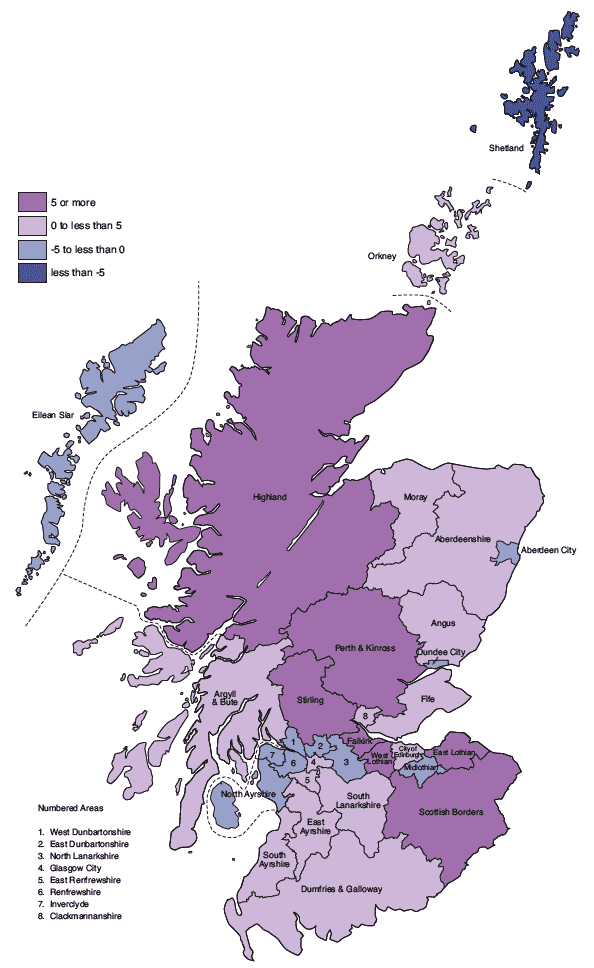
The patterns of migration over the period 1997 to 2007 indicate that the highest net out-migration rates were in Shetland Islands, Dundee City and East Dunbartonshire. The highest net in-migration rates were in Perth & Kinross, East Lothian and Scottish Borders.
Numbers
There were 29,866 marriages in Scotland in 2007, 30 (0.1 per cent) fewer than in 2006. Figure 1.32 shows that, following a decline from over 40,000 marriages a year in the early 1970s, the annual total has levelled out at around 30,000. The highest total recorded in recent years was 32,154 in 2004.
The information in this section covers all marriages registered in Scotland, regardless of the usual residence of the parties involved. In 2007, there were 7,959 marriages (27 per cent) where neither the bride nor groom was resident in Scotland. This represents a slight fall from 8,079 in 2006. Gretna continues to be a popular venue for marriages, though the 4,452 registered in 2007 was a fifth down on the record total of 5,555 in 2004. In 2007, 86 per cent (3,812) of the marriages at Gretna did not involve a Scots resident.
Of course, many couples who are resident in Scotland go abroad to be married. These marriages are not included, and only some come to the attention of the Registrar General through notification to British consular authorities.
Figure 1.32 Marriages, Scotland, 1971-2007
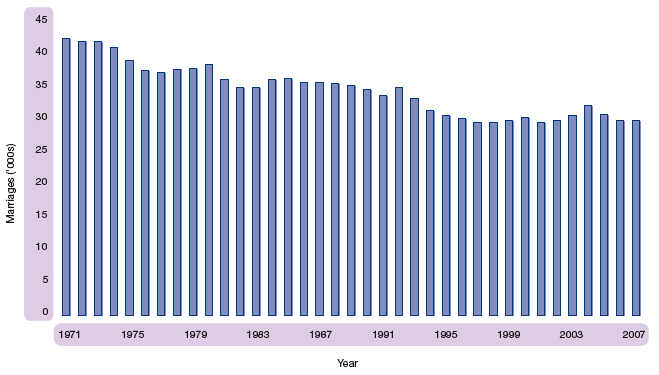
Marital status at marriage
Figure 1.33 shows the percentage of marriages by marital status at the time of marriage between 1971 and 2007. The percentage of people marrying who had been divorced rose from just under 6 per cent in 1971, to over a quarter in 2007 (28 per cent for males and 26 per cent for females). The majority of this shift reflects a reduction in the proportion of marriages where one of the partners had never been married. However, the proportion of those marrying who were widowed has also declined slightly – in 2007, the proportion was just over 2 per cent whereas it was just over 3 per cent in 1971.
Figure 1.33 Marriages, by marital status and sex of persons marrying, 1971-2007
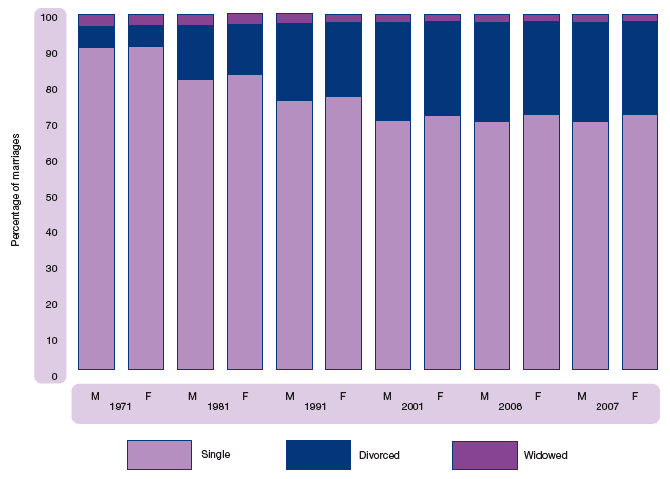
Age at marriage
The average age at marriage continues to rise for both males and females. For first marriages, the average age of grooms has risen from 29.5 in 1997 to 32.2 in 2007; the comparable figures for brides are 27.3 in 1997 and 30.3 in 2007.
Marriages by type of ceremony
Civil marriages accounted for just over half (52 per cent) of all marriages in 2007 compared to just under one-third (31 per cent) in 1971 (Figure 1.34). The trend mainly reflects a decline in the number of religious ceremonies during the 1970s, 1980s and early 1990s. The small increase in religious marriages observed during the period 1997-2002 was largely associated with the increase of ‘tourism’ marriages, of which a significant proportion were carried out at Gretna.
Figure 1.34 Marriages, by type of ceremony, 1971-2007
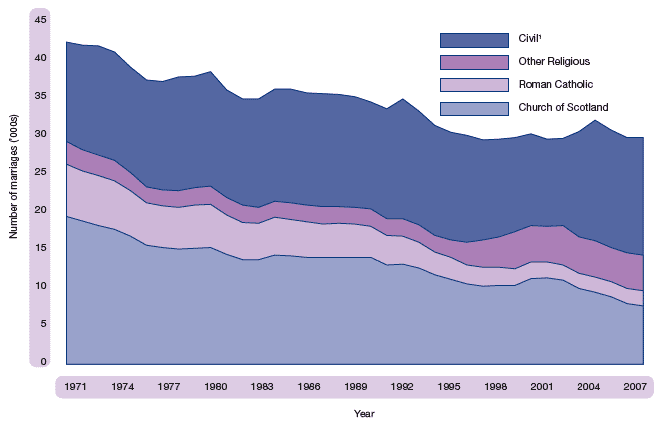
1 Includes very small numbers of ‘irregular’ marriages established by Decree of Declaration of the Court of Session.
Until 2002, civil marriages could only be held in registration offices. The Marriage (Scotland) Act 2002 allowed registrars to conduct ceremonies in other approved places, from June 2002. Nearly 800 venues have now been approved, including castles, hotels, clubs and a small number of outdoor venues in gardens or the countryside.
During 2007, 7,987 civil ceremonies (27 per cent of all marriages and 52 per cent of civil marriages) were conducted at these ‘approved places’. This represented an increase of 9 per cent on 2006 and an increase of 131 per cent on 2003, the first full year of the new arrangements. There has been a corresponding decrease in the number of religious marriages, from 16,890 in 2003 to 14,381 in 2007.
Almost two-thirds (63 per cent) of the religious marriages were celebrated in places of worship while just under half (48 per cent) of civil marriages took place in registration offices. Hotels were the venue for about 2,300 religious and 3,400 civil ceremonies, while approximately 900 religious and 600 civil marriages took place in castles and other historic buildings and 27 religious and
19 civil marriages were held on ships and barges.
Numbers
The number of divorces in 2007 was 12,773, 241 (2 per cent) fewer than in 2006. Changes to divorce legislation were introduced by the Family Law (Scotland) Act 2006. The changes, which came into effect on 4 May 2006, reduced separation periods for divorce with consent to one year (previously two years) and without consent to two years (previously five years).
Figure 1.35 shows the number of divorces between 1971 and 2007. There was a marked increase in the number of divorces up to a peak of over 13,373 in 1985. Recent years have seen a slight fall from the levels recorded in the late 1980s and 1990s perhaps because more couples are cohabiting without getting married, and divorce proceedings are not necessary to sever such relationships. The recent peak in 2006 (13,014 divorces), the highest figure since 1985, was expected as a result of the change in legislation, because some divorces which were finalised in 2006 would otherwise have taken place in later years. It is likely that the impact of this change will reduce over the next few years.
The information in this report covers divorces granted in Scotland, regardless of where the marriage took place.
Figure 1.35 Divorces, Scotland, 1971-2007
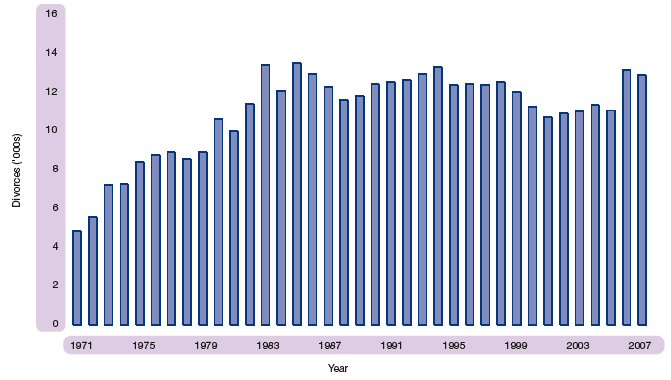
Grounds for divorce
Figure 1.36 shows the trends in grounds for divorce between 1981 and 2007. For 2006 and 2007, it includes the new categories introduced by the Family Law (Scotland) Act 2006. Non-cohabitation/ separation was the most frequent reason for divorce, accounting for 92 per cent of all divorces in 2007, more than double the 39 per cent attributed to the non-cohabitation categories in 1981. Behaviour as the stated reason for divorce fell from 42 per cent to 7 per cent; and adultery as the stated reason for divorce fell from 17 per cent to 1 per cent.
Figure 1.36 Number of divorces, by grounds for divorce, Scotland, 1981-2007
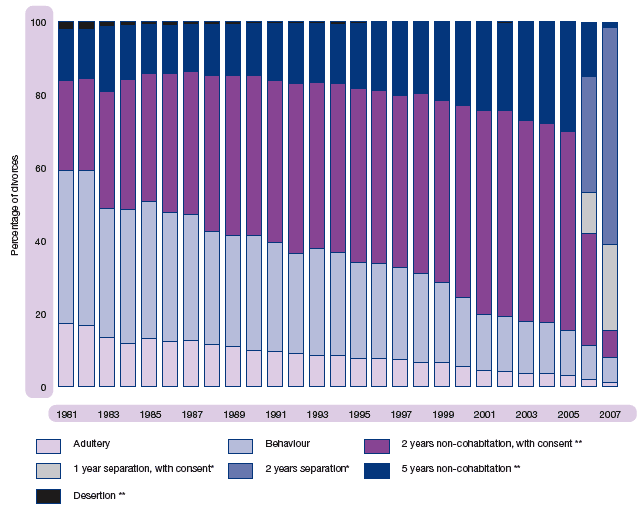
Divorces by marital status
Of those divorcing in 2007, 17 per cent of both men and women had divorced previously. This compares with 8 per cent for men and 7 per cent for women in 1981. This is consistent with the increase in the proportion of all marriages where one or both participants was divorced previously (now 2 in 5 marriages compared with 1 in 4 twenty years ago).
Duration of marriages that ended in divorce
In 2007 and 1997 the median duration of marriage ending in divorce was 15 years. This was much lower in 1981 when the average was 9 years.
Divorce by age at marriage
In 2007, 15 per cent of all divorces involved couples where at least one of the partners was aged 20 or under when they married. This is a significant fall from 60 per cent in 1981, but not unexpected given that the proportion of marriages where at least one of the partners was aged 20 or under has fallen from 36 per cent in 1981 to 1 per cent in 2007.
The Civil Partnership Act 2004, which applies throughout the UK, came into force on 5 December 2005, allowing same-sex couples to register their partnership. In Scotland, the first civil partnership was registered on 20 December 2005 and by the end of that year a total of 84 had been registered – 53 male couples and 31 female couples. During 2006, the first full year of operation, a further 1,047 partnerships were registered, 580 male couples and 467 female couples. In 2007, 688 partnerships were registered – 339 male couples and 349 female couples. This decrease was expected, because many long-standing relationships will have been registered as civil partnerships in the first full year of registration in 2006.
The Registrar General recorded 441 adoptions during 2007 – 23 more than in 2006, and just over half the number recorded in the early 1990s, or around a quarter of the number recorded in the 1970s.
Thirty per cent of the children adopted in 2007 were adopted by a step-parent and 66 per cent were adopted by non-relatives of the child. Only 11 per cent of children adopted in 2007 were aged under 2, nearly all being adopted by non-relatives. By contrast, only 14 per cent of the 93 adoptions of children aged 10 or over were by non-relatives.
The Gender Recognition Act 2004 came into force on 4 April 2005. The Act applies throughout the UK and enables transsexual people to apply to the Gender Recognition Panel to obtain a Gender Recognition Certificate. Successful applicants are considered from the date of issue of the Certificate to be legally of their acquired gender. A holder of a Gender Recognition Certificate is able to enjoy all the rights appropriate to a person of his or her acquired gender, including obtaining a new birth certificate showing his or her recognised legal gender.
The Registrar General for Scotland has set up a Gender Recognition Register in which the birth of a transsexual person whose acquired gender has been legally recognised is registered showing any new name(s) and the acquired gender. This enables the transsexual person to apply to the Registrar General for Scotland for a new birth certificate showing the new name(s) and the acquired gender. In 2007, there were 30 entries in the Gender Recognition Register, 13 fewer than in 2006. The Gender Recognition Register is not open to public scrutiny.
Vacant dwellings and second homes
Across Scotland as a whole in mid-2007, 2.8 per cent of dwellings were vacant and 1.4 per cent were second homes, though there is wide variation across the country. Figure 1.37 shows the variation in the proportions of vacant dwellings and second homes between urban and rural areas. Remote rural areas have the lowest percentage of dwellings which are occupied (88 per cent), with relatively high percentages of vacant dwellings (5 per cent of all dwellings in these areas) and second homes (7 per cent).
Figure 1.37 Vacant dwellings and second homes, by urban-rural area, 2007
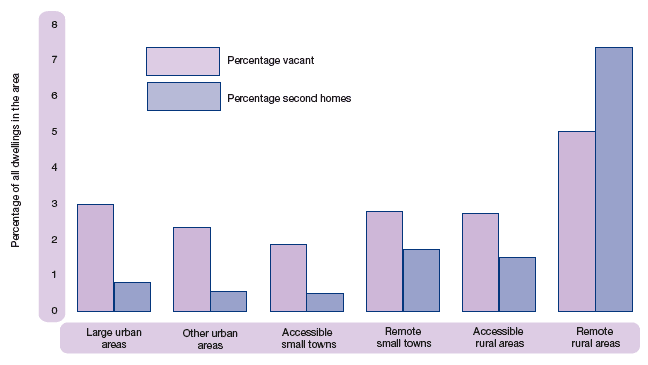
Dwelling type
There are higher proportions of flats in urban areas, and in more deprived areas. In contrast, there are higher proportions of detached houses in rural areas, and in less deprived areas. The three island authorities have the highest percentages of detached dwellings (over 58 per cent of all dwellings in these areas, compared to 20 per cent for Scotland as a whole).
Figure 1.38 shows the percentage of dwellings in each local authority area which are flats. Urban areas, and areas closer to the ‘Central Belt’ of Scotland, tend to have higher proportions of flats.
Figure 1.38 Percentage of dwellings which are flats in each local authority area, 2007
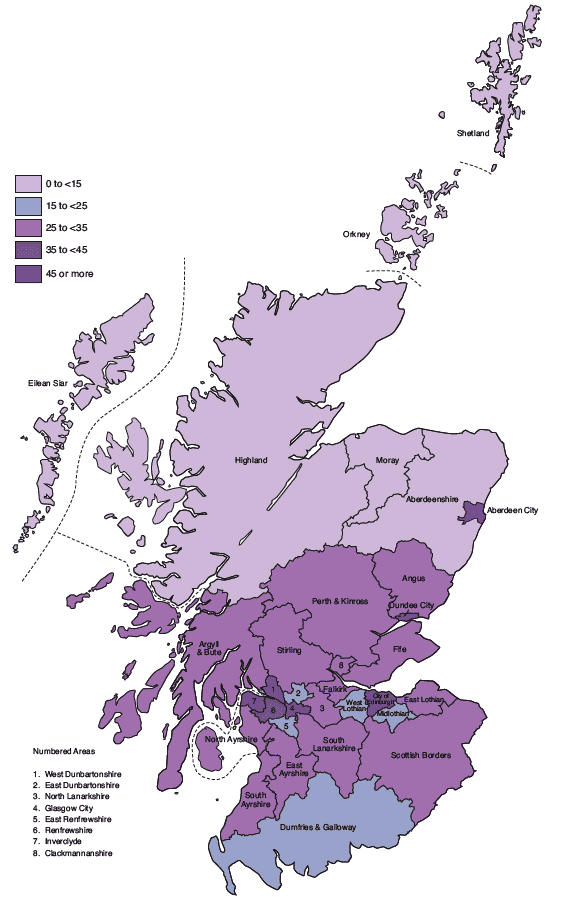
In mid-2007, there were 2.3 million households in Scotland, which is 22,400 more than in mid-2006 and over 270,000 more than in 1991. Between 2006 and 2031, the number of households in Scotland is projected to increase to 2.7 million, which is an average of 17,600 additional households per year. Most of the increase is the result of an ageing population and more people living alone or in smaller households, rather than an increase in the overall population. Looking to the future, there is a projected increase in the number of people in older age groups, with a fall in the number of younger people. This has an impact on household structure, as elderly people are more likely to live alone or with just one other person and children tend to live in larger households.
Household type
Figure 1.39 shows the numbers of households of each type in 2006 and the projected number in 2031. There is a large projected increase in households containing just one adult, from 809,000 (35 per cent of all households) in 2006 to over 1.2 million (44 per cent) in 2031.
In contrast, the number of larger households is projected to fall, with households containing two or more adults with children decreasing from 443,000 (19 per cent of all households) in 2006 to 300,000 (11 per cent) by 2031.
Figure 1.39 Households in Scotland by household type: 2006 and 2031
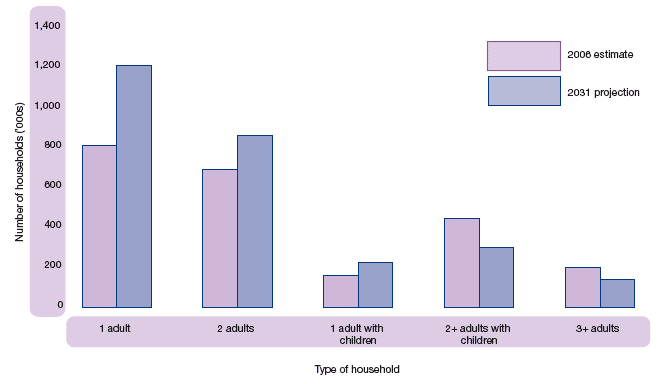
Age of head of household
Figure 1.40 shows the number of households in 2006 and the projected number in 2031, by the age of the head of household. Scotland’s population is ageing, with a projected increase in the number of people in the older age groups. This trend is reflected in the household projections, with the largest increases shown in households headed by people aged 60 or over (an increase of over a half from 753,000 to 1.14 million between 2006 and 2031). In contrast, households headed by someone aged under 60 are projected to increase by just 4 per cent, to around 1.59 million. The number of households headed by someone aged 85 or over is projected to more than double over the same period, from 69,000 to 177,000.
Figure 1.40 Households in Scotland by age of head of household: 2006 and 2031
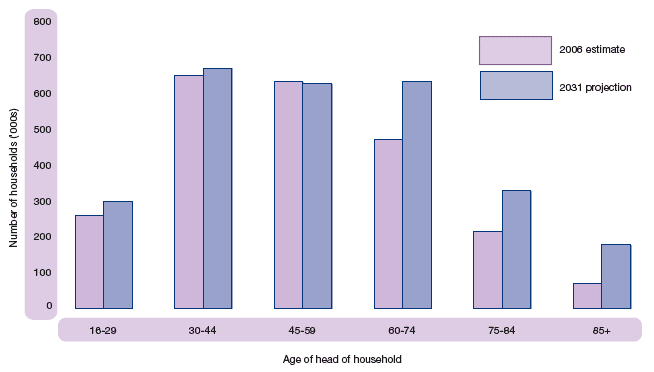
Variations within Scotland
The number of households in almost every local authority area is projected to increase. Figure 1.41 shows the projected percentage change in the number of households in each local authority area between 2006 and 2031.
The largest projected increases are in Orkney, West Lothian and Edinburgh (all 35 per cent). Perth and Kinross, Aberdeenshire and East Lothian also have projected increases over 30 per cent. In contrast, Inverclyde has a projected decrease of 3 per cent over the same period, and East Dunbartonshire has a projected decrease of 2 per cent.
Figure 1.41 Projected percentage change in households by local authority area, 2006 to 2031
